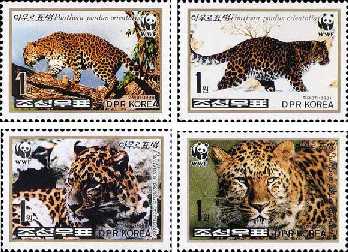Previous Years
1998 Issues
230 - Kiribati
231 - Mali
232 - Tirks & Caicos
233 - Lesotho
234 - Bosnia & Herzegovina
235 - Niuafo'ou
236 - Liberya
237 - Cyprus
238 - Australia
239 - Comoros
240 - Ukraine
241 - New Caledonia
242 - Cuba
243 - Somalia
244- Afghanistan
245 - North Korea
246 - Niger
247 - South Africa
1999 Issues
2000 Issues
2001 Issues
2002 Issues
The original range of the Amur leopard included Manchuria (China)
and the Korean Peninsula. Today, much of its habitat within China
has been destroyed, while the status of the cat in North Korea is
unknown and it has vanished from South Korea. This leaves a small
range along the Chinese-Russian border (west of Vladivostok)
containing the only viable population.
The Amur leopard is listed as critically endangered with, at most,
20-30 remaining in Russia and no more than 10 to be found in China.
At the present time there still exist large tracts of forest which
are ideal
leopard habitat. If these areas can be protected from logging companies
the chance exists to increase wild leopard numbers.
Leopard kills are often dragged up into trees before being consumed.
The tiger is essentially a terrestrial animal and prefers being on
the ground.
Despite having incredible muscle power, when climbing, they are very
clumsy. On the other paw, the leopard can hang motionless from the
bark
of a vertical tree trunk, then by using its sheer strength can propel
itself aloft. These are extremely agile cats that can jump vertically
up to
10 feet and double this length horizontally. Pound for pound they are
10 times as strong as humans, successfully carrying prey 3 times their
own
weight into the branches. This protects their food from other predators,
including the main subject of this Web site, the tiger. Once a meal
is finished
the leopard is quite capable of descending a tree head first.
Overall, there are more than 20 subspecies of leopard; they are located
in
both Asia and Africa. In fact, the leopard is the widest-ranging big
cat and
extremely adaptable. They live in a variety of habitats, ranging from
jungles
to deserts, while some can be found located near large cities. Eight
subspecies are endangered, four of these critically.

Animal: Amur Leopard /Panthera pardus orientalis
Iissue Date: October 21, 1998
Values: 4 x 1won
Printing: ???
Printed in: ???
Artwork: Jo Jong Gu
September -25 - 2002
North Korea stamps - Korea Stamp Corporation
Amur Leopard - Amur Leopard.org
HOME Page
My Other Philatelic Interests
Collector's Corner
 ABOUT
THE HISTORY OF WWF LOGO
ABOUT
THE HISTORY OF WWF LOGO